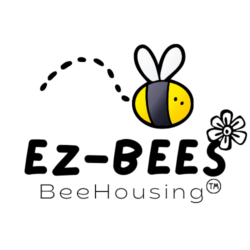To save honey bees we need to design them new hives-The Conversation September 2019
Simple changes to hive design in order to lower heat loss and increase humidity, for example using smaller entrances and thicker walls, could reduce the stress on the honey bee colonies caused by Varroa. We already know that simply building hives from polystyrene instead of wood can significantly increase the survival rate and honey yield of the bees.
Colony Mass – Survival Analysis September 2015
Unvented tree enclosures hint at higher humidity in the nest, increased survival of smaller colonies and lower Varroa breeding success. Many honeybee behaviors may only be a coping mechanism for human (bad) hive design.
Honey bee Engineering: Top ventilation and top entrances
– American Bee Journal – November 2017
“…any thermal advantage of the insulation can be negated and perhaps even reversed by the addition of a top vent. Without the top vent, the air would be hot and humid, good for bees.”
Insulating Hives in Hot Weather – Two Bees in a Podcast -June 2021
Northern beekeepers are discovering the benefits of winter insulation. Mitchell shares exciting research on honey yield and pest control in HOT weather.
Thermal Efficiency – Bee Culture – May 2019
By improving the thermal efficiency of the hives and the bee keeping practices we use, we can make the honey bees job of converting nectar into honey easier. This can mean significant improvements in survival of colonies and greater honey yields
The Real Buzz on Honeybee Insulation – November 2023
A new study at the University of Leeds indicates that traditional beekeeping hives may be causing thermal stress to bees by increasing heat loss. His findings challenge the accepted theory of bee clustering for insulation, suggesting an urgent need to revise beekeeping practices for better bee welfare.
Profile
Initially set out on a career in Mechanical Engineering but switched to the world of Microelectronics via Physics and thus later to Telecommunications and now back to Mechanical Engineering with a perhaps surprising application area – honey bees.
Research interests
Honeybees are an extended organism. That is to say their immediate environment is closely bound into their behaviour. A consequence of the fact that they spend over 80% of their lifespan in their nest. They don’t hibernate and must keep part of their nest all year above 18C yet they can be found where the winters go to -40C. Their nest is not only a place to raise young, which must kept within 34C +/- 1C to successfully develop, but is also a sugar refining factory, changing sugar solution concentrations from 20% to 80+% in quantities of over 1Kg per day.
It is clear that heat transfer inside and to the outside of the nest is a integral to the life and success of honeybees. But almost nothing is known about it. This is partly because the expertise is associately usually with non-biological concerns and partly because it is difficult to study or measure heat flow in a box full of venomous insects and even more difficult when those insects are deep inside a massive tree. This is where computational fluid dynamics comes in. It allows simulation and measurement of complex and difficult to instrument systems. Earlier studies have shown by experimental simulation that there is an order of magnitude difference between man-made hives and their natural abode of tree hollows in just the lumped thermal conductance of the enclosure, taken as a empty enclosure and a simple heat source. Because honeybees have to date only been studied in manmade boxes and not in trees or tree like structure , The internal structures the honeybees build that affect heat transfer have not been measured nor has the distribution of the honey bees, in what is a dramatically different thermal environment. Therefore part of the research will involve studying and measuring what honeybees do in tree like structures to provide data for the CFD work.


